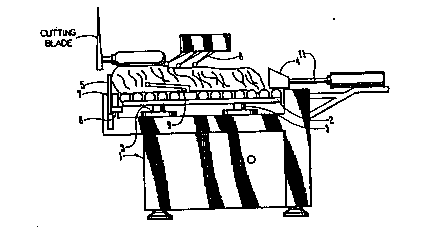Une partie des informations de ce site Web a été fournie par des sources externes. Le gouvernement du Canada n'assume aucune responsabilité concernant la précision, l'actualité ou la fiabilité des informations fournies par les sources externes. Les utilisateurs qui désirent employer cette information devraient consulter directement la source des informations. Le contenu fourni par les sources externes n'est pas assujetti aux exigences sur les langues officielles, la protection des renseignements personnels et l'accessibilité.
L'apparition de différences dans le texte et l'image des Revendications et de l'Abrégé dépend du moment auquel le document est publié. Les textes des Revendications et de l'Abrégé sont affichés :
| (12) Demande de brevet: | (11) CA 2133953 |
|---|---|
| (54) Titre français: | MACHINE A TRANCHER LA VIANDE, ET SA METHODE D'UTILISATION |
| (54) Titre anglais: | MEAT SLICING MACHINE AND METHOD OF USE THEREOF |
| Statut: | Réputée abandonnée et au-delà du délai pour le rétablissement - en attente de la réponse à l’avis de communication rejetée |
| (51) Classification internationale des brevets (CIB): |
|
|---|---|
| (72) Inventeurs : |
|
| (73) Titulaires : |
|
| (71) Demandeurs : |
|
| (74) Agent: | |
| (74) Co-agent: | |
| (45) Délivré: | |
| (86) Date de dépôt PCT: | 1993-04-16 |
| (87) Mise à la disponibilité du public: | 1993-11-11 |
| Requête d'examen: | 1995-03-17 |
| Licence disponible: | S.O. |
| Cédé au domaine public: | S.O. |
| (25) Langue des documents déposés: | Anglais |
| Traité de coopération en matière de brevets (PCT): | Oui |
|---|---|
| (86) Numéro de la demande PCT: | PCT/US1993/003649 |
| (87) Numéro de publication internationale PCT: | US1993003649 |
| (85) Entrée nationale: | 1994-10-20 |
| (30) Données de priorité de la demande: | ||||||
|---|---|---|---|---|---|---|
|
2133953 9322114 PCTABS00027
A meat slicing machine has a frame (1) and a meat supporting bed
(2) having a load cells (3) associated with supporting bed (2)
for weighing the meat product on the bed. Gripper claws of a
gripper box (4) are adapted to grip the meat product. A pressure plate
(5) having a limit switch (6) is adapted to be engaged by the
meat product. A shear-edge (7) is provided on frame (1) as the meat
product passes under measuring lasers (8). A profile finger (9)
measures the width of the meat product. Lasers (8) or
potientometers (10) measure the height of the product. The lead screw (11)
pushes the meat product towards the pressure plate (5) to measure
the length of the product. The method involves weighing the meat
product, measuring the height, length and width of the meat
product; determining the volume and density of the meat product; and
slicing a portion of the meat product having a predetermined weight
into a plurality of slices having a uniform thickness.
Note : Les revendications sont présentées dans la langue officielle dans laquelle elles ont été soumises.
Note : Les descriptions sont présentées dans la langue officielle dans laquelle elles ont été soumises.

2024-08-01 : Dans le cadre de la transition vers les Brevets de nouvelle génération (BNG), la base de données sur les brevets canadiens (BDBC) contient désormais un Historique d'événement plus détaillé, qui reproduit le Journal des événements de notre nouvelle solution interne.
Veuillez noter que les événements débutant par « Inactive : » se réfèrent à des événements qui ne sont plus utilisés dans notre nouvelle solution interne.
Pour une meilleure compréhension de l'état de la demande ou brevet qui figure sur cette page, la rubrique Mise en garde , et les descriptions de Brevet , Historique d'événement , Taxes périodiques et Historique des paiements devraient être consultées.
| Description | Date |
|---|---|
| Inactive : CIB de MCD | 2006-03-11 |
| Le délai pour l'annulation est expiré | 1998-04-16 |
| Demande non rétablie avant l'échéance | 1998-04-16 |
| Réputée abandonnée - omission de répondre à un avis sur les taxes pour le maintien en état | 1997-04-16 |
| Exigences pour une requête d'examen - jugée conforme | 1995-03-17 |
| Toutes les exigences pour l'examen - jugée conforme | 1995-03-17 |
| Demande publiée (accessible au public) | 1993-11-11 |
| Date d'abandonnement | Raison | Date de rétablissement |
|---|---|---|
| 1997-04-16 |
Les titulaires actuels et antérieures au dossier sont affichés en ordre alphabétique.
| Titulaires actuels au dossier |
|---|
| TOWNSEND ENGINEERING COMPANY |
| Titulaires antérieures au dossier |
|---|
| JOSEPH CAREY |